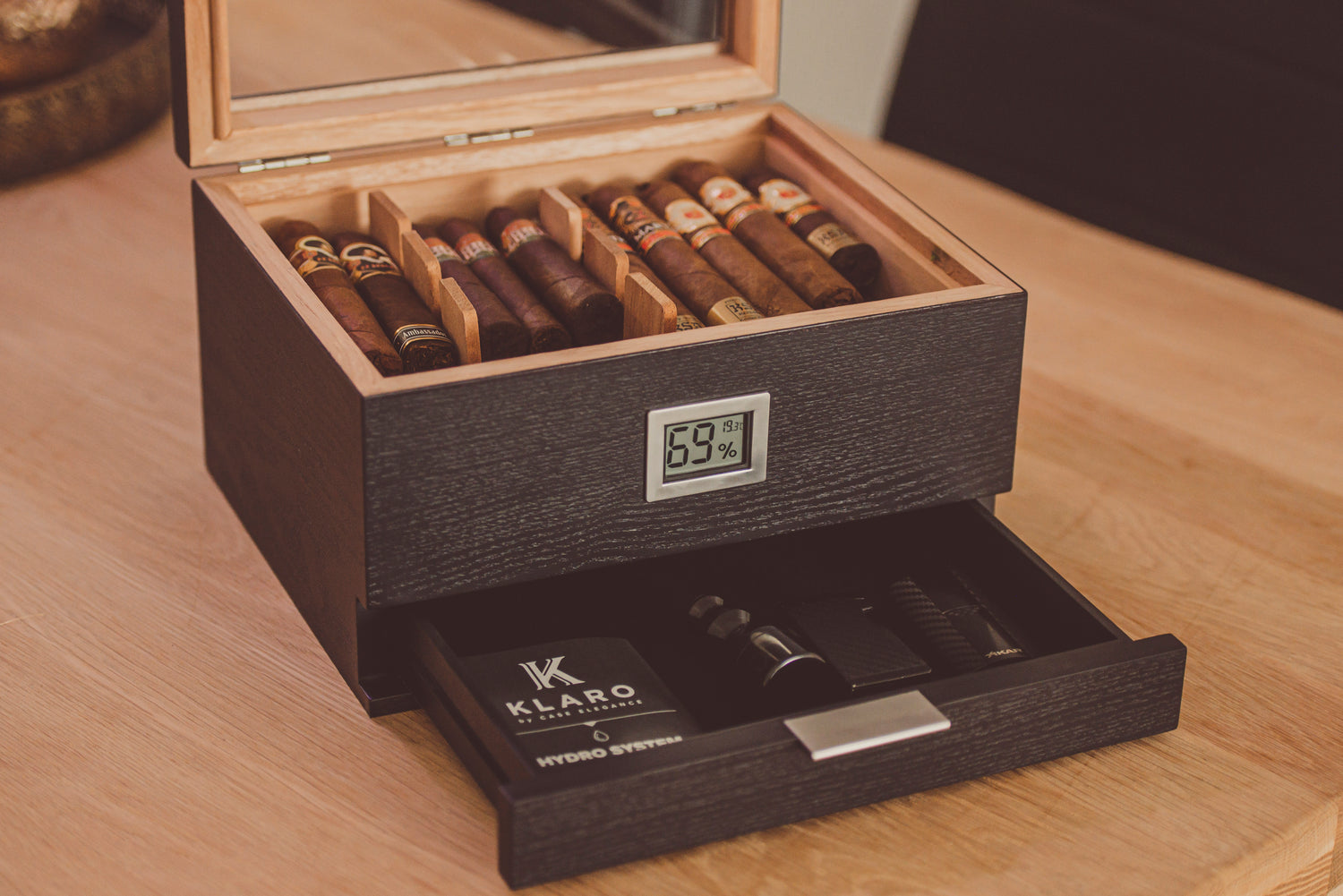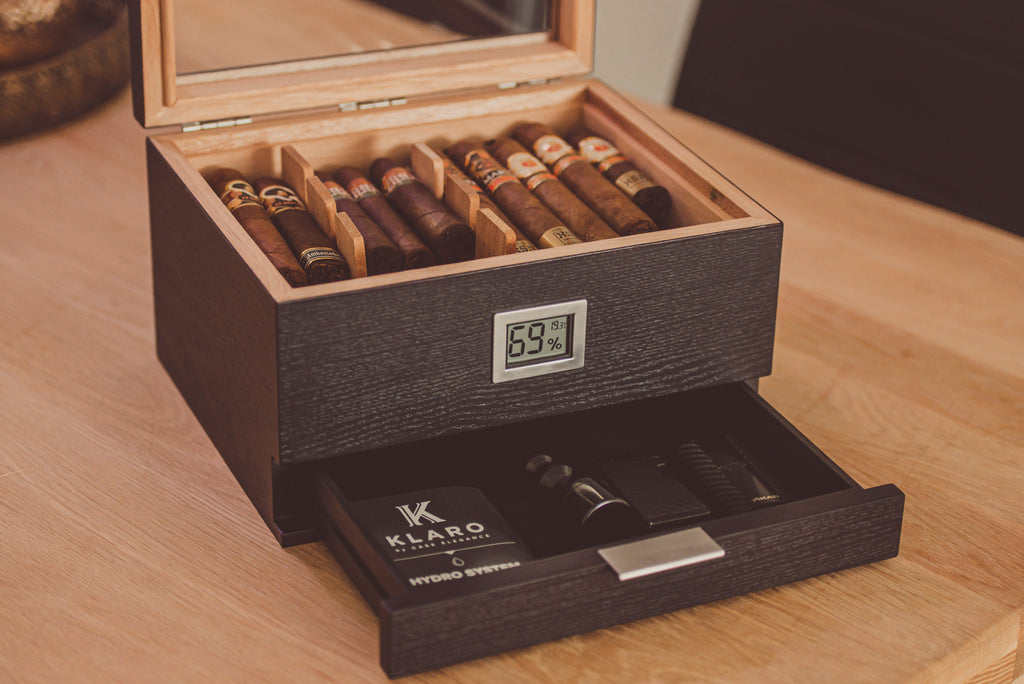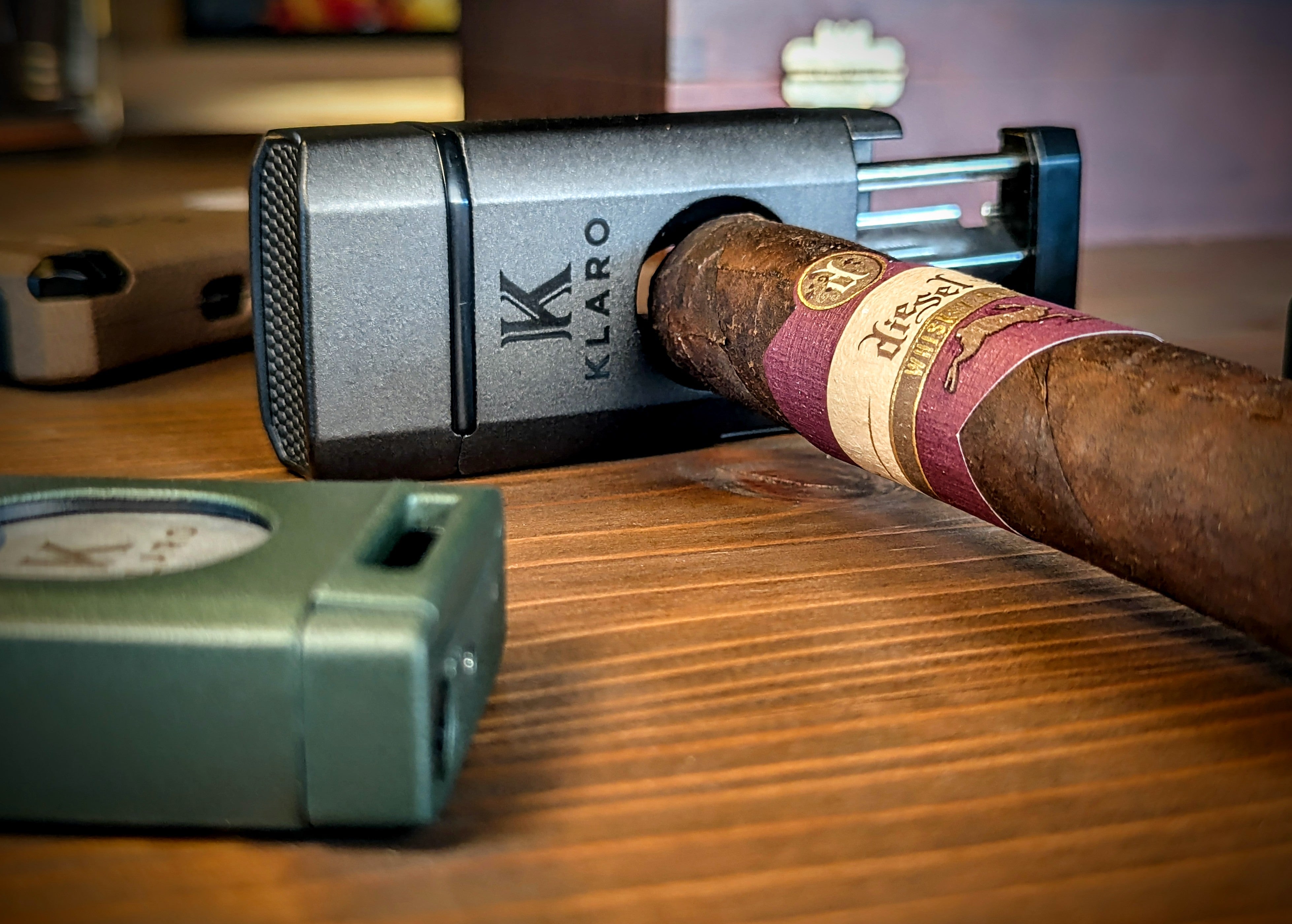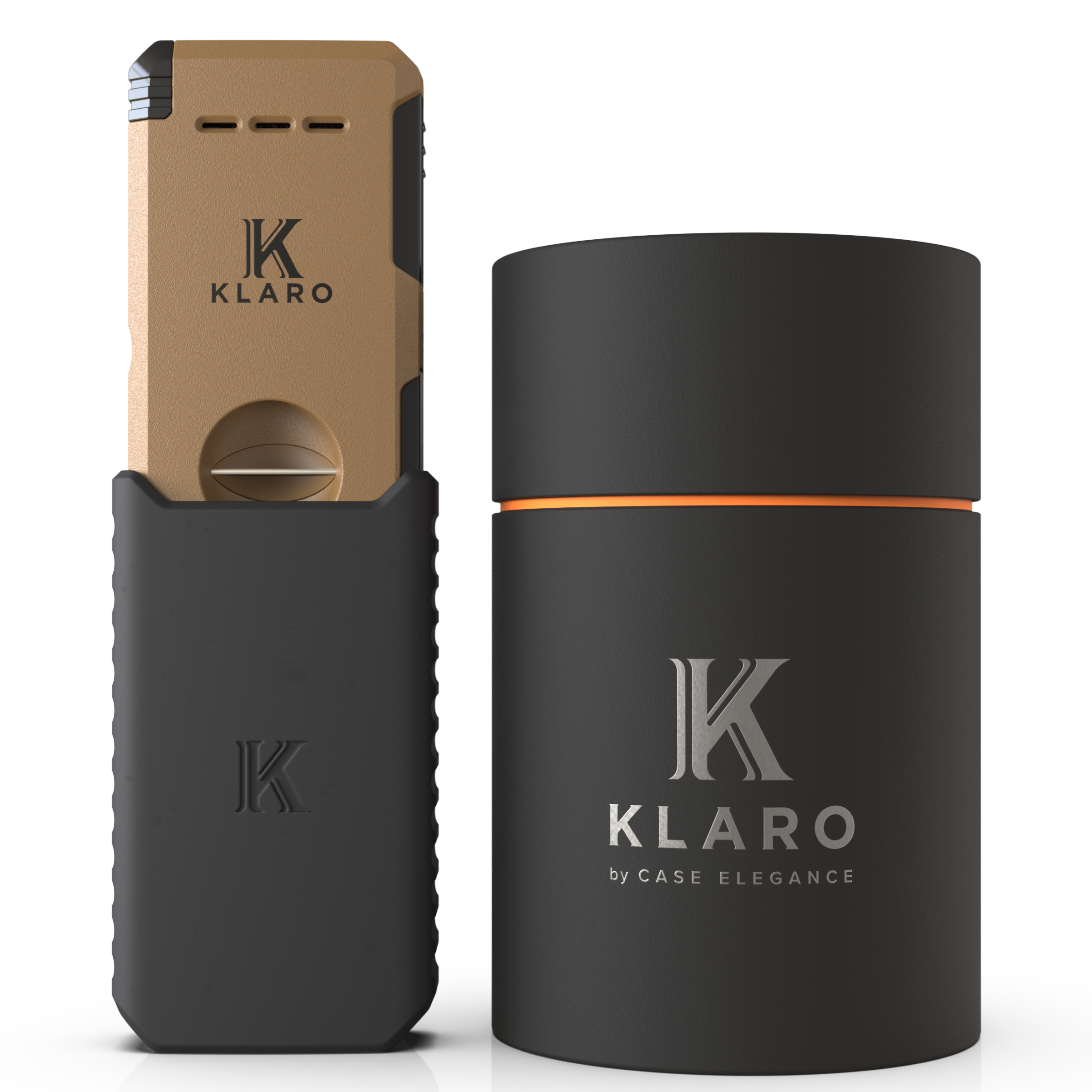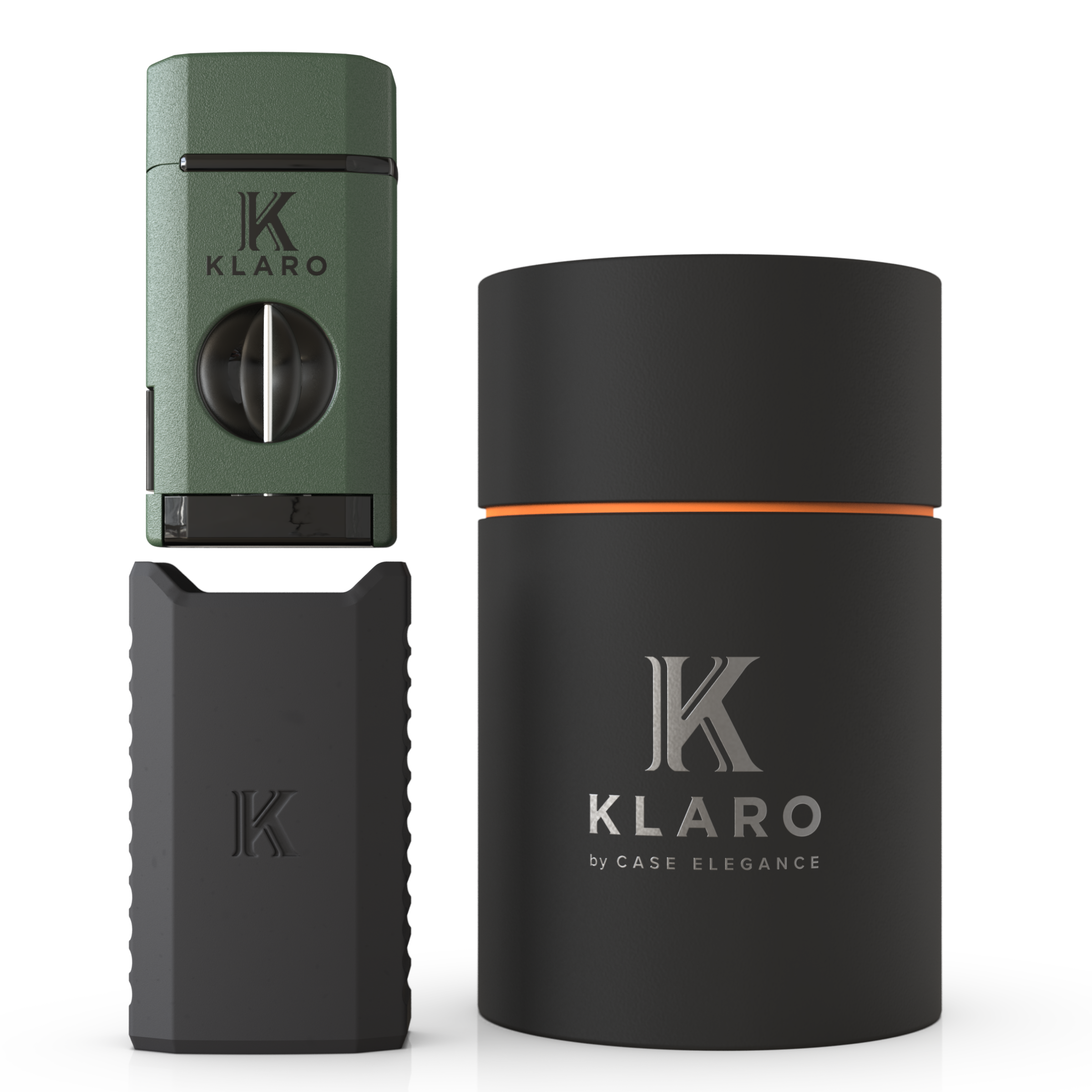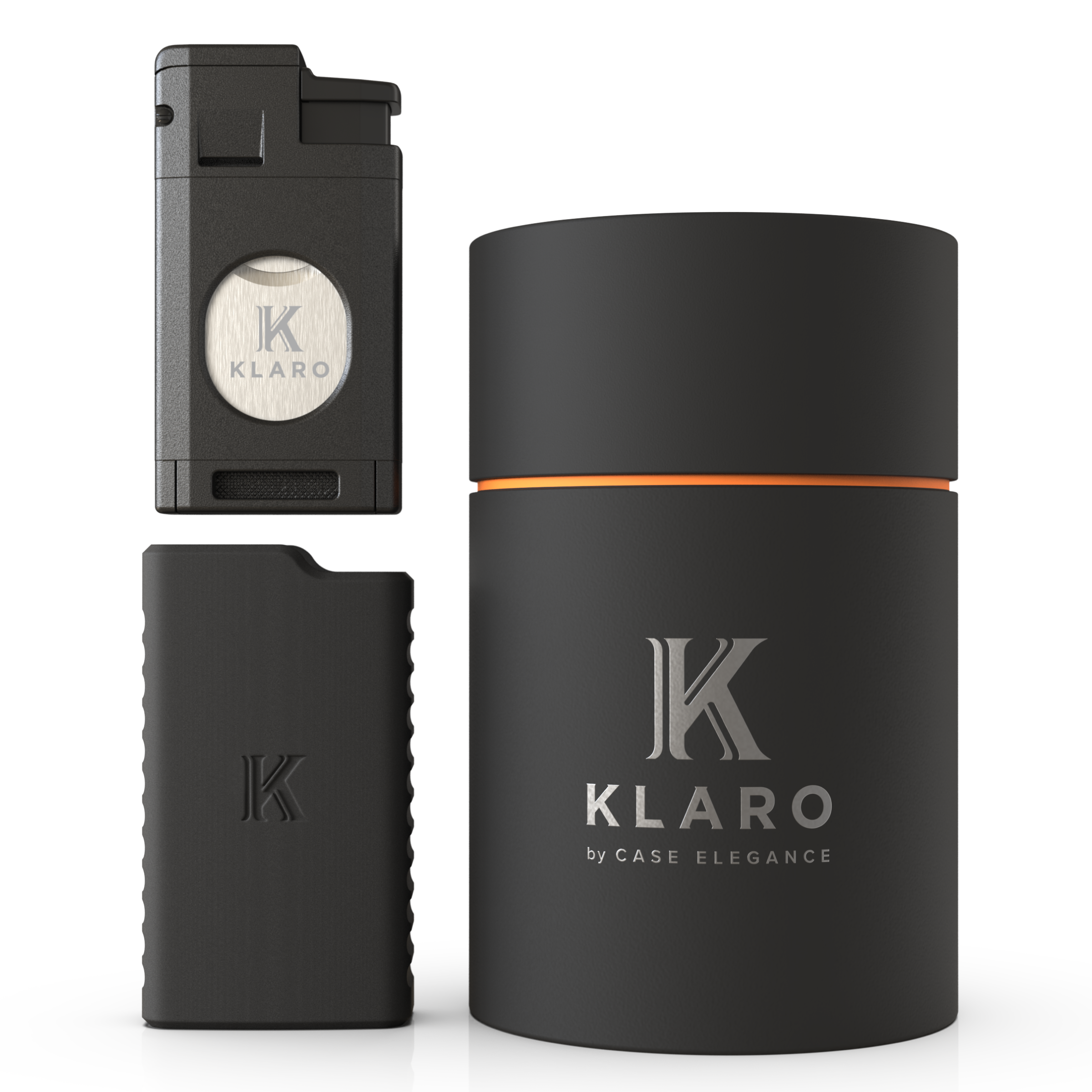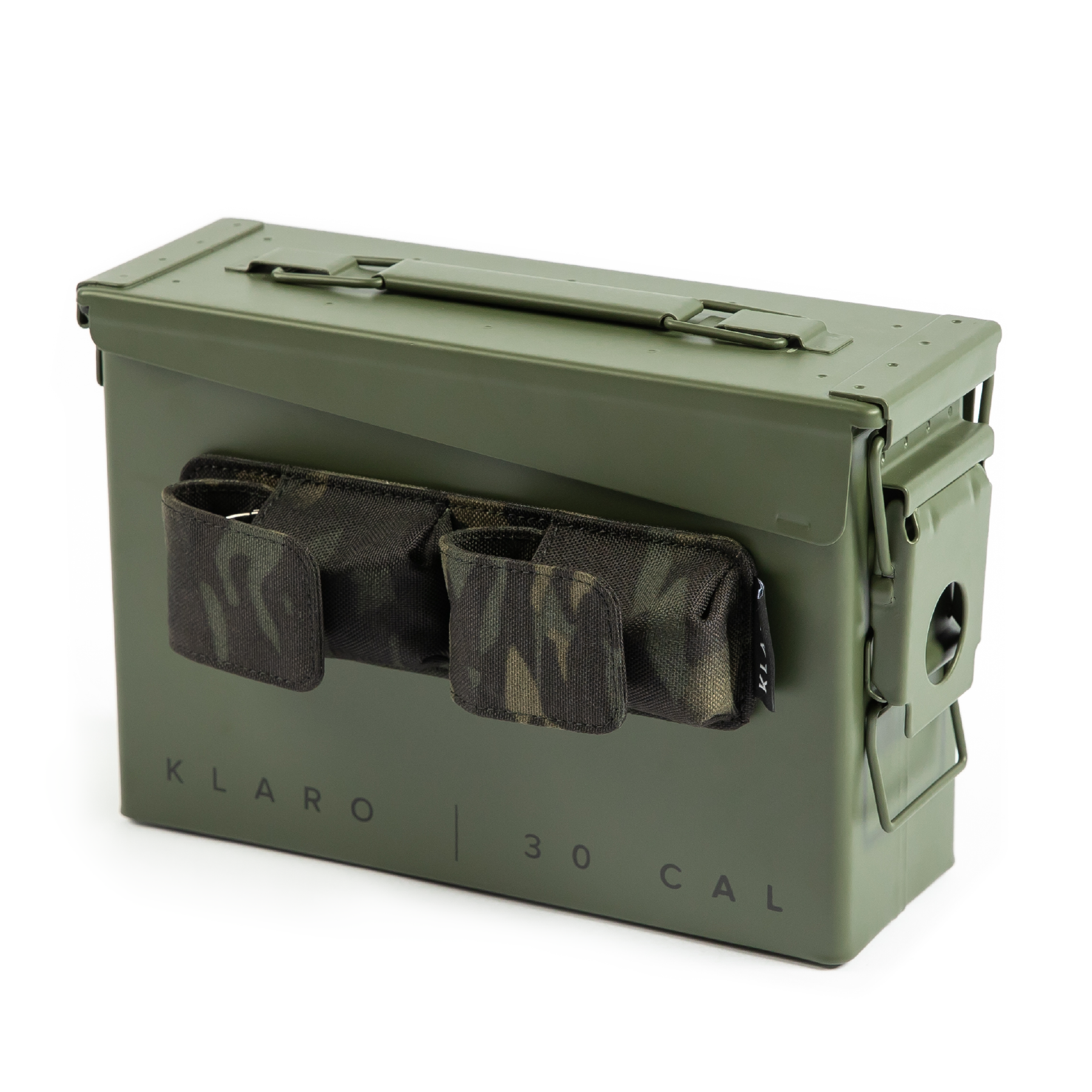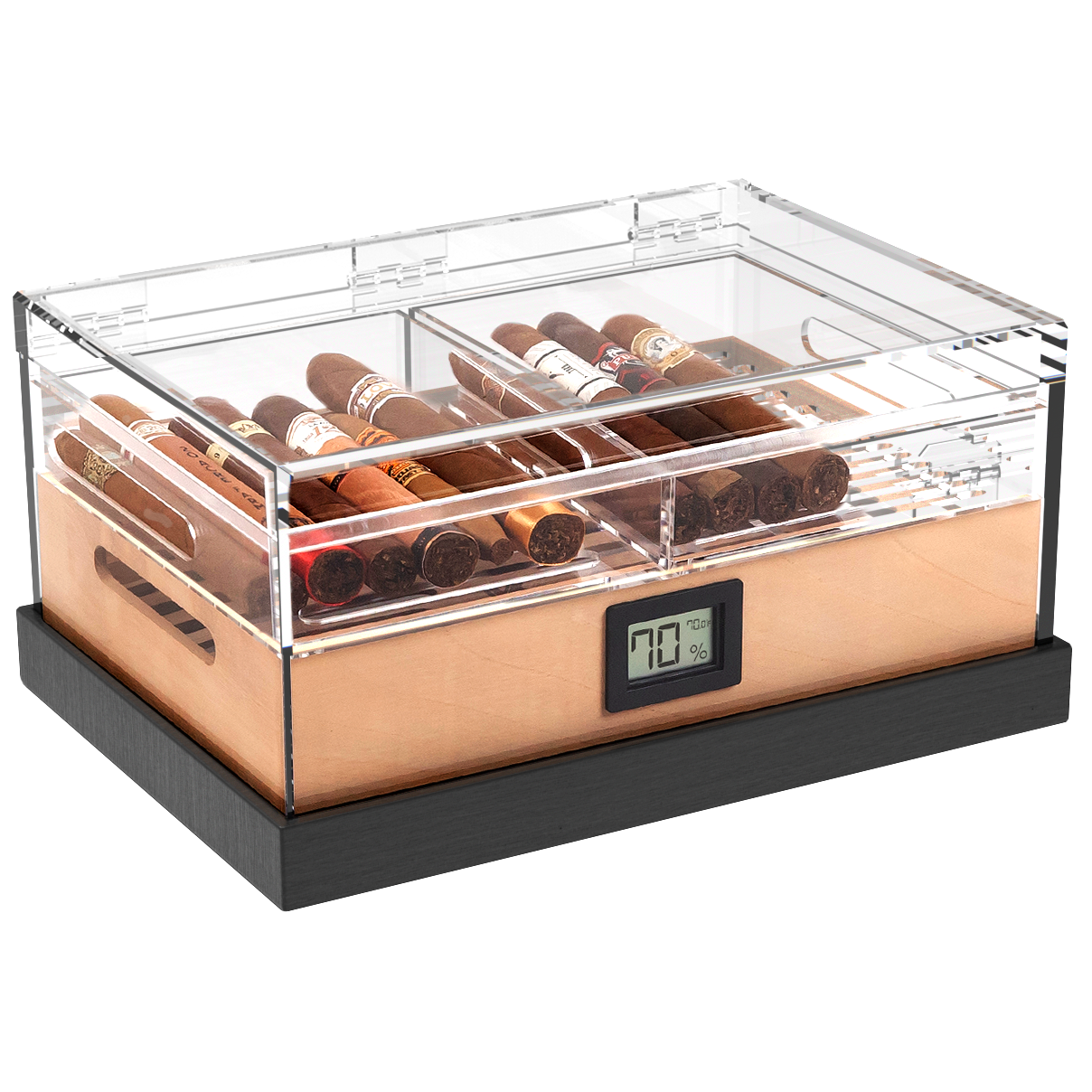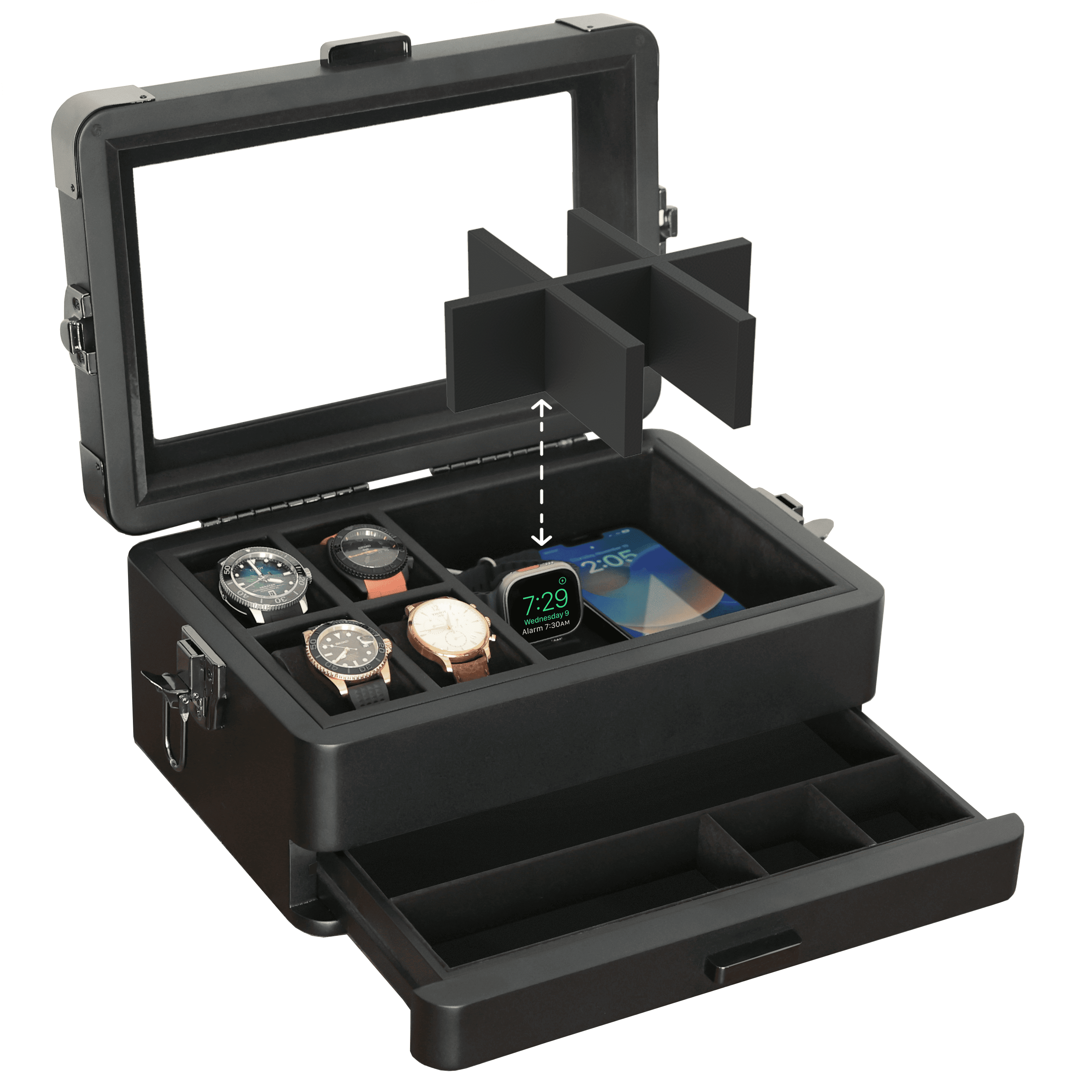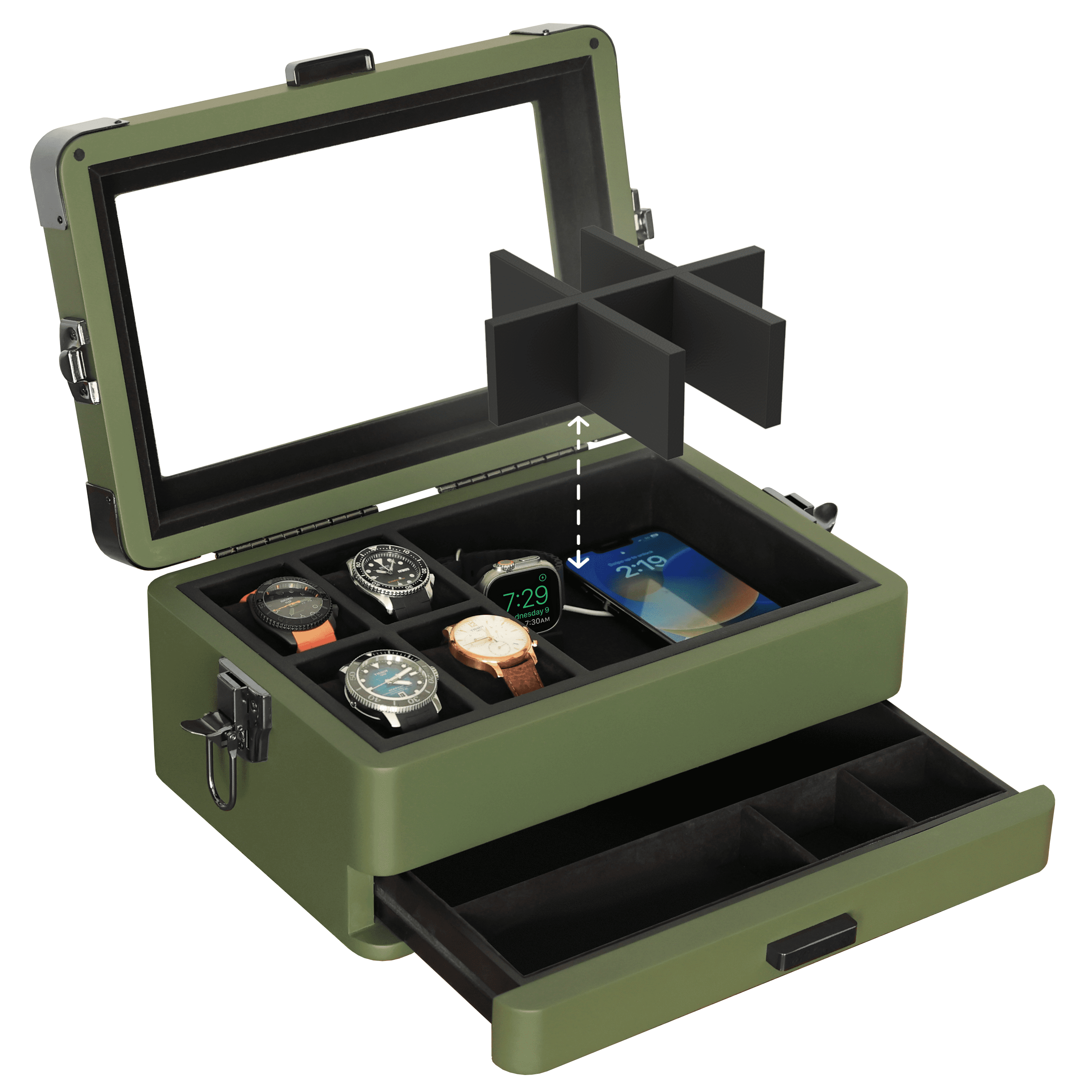Humidors are a relatively simple tool when you break down the concept. Wood, humidity control, a lid. Sure, add in a hygrometer to help you regulate the relative humidity. But, stranded on a deserted island with no other options, you could get by.
On the other end of the spectrum are the elaborate humidor cabinets, walk-in humidors, and temperature-controlled frigadors where you can monitor storage conditions like the inside of a laboratory. Still, the concept is the same: store your cigars in a humidity-controlled, safe location.
Somewhere in between those two sides of the spectrum are the humidors most cigar smokers own and enjoy. Desktop humidors, high-end travel humidors, glass-top humidors–maybe a cabinet. Our lineup of Klaro humidors includes the following: the Renzo, the Octador, the Primera Glass top. High quality, medium capacity, and stylish–something you wouldn’t mind showing off even to the tasteful non-smoker. Also, they’re still relatively simple in design: wood, humidity control, digital or analog hygrometer, and a lid with a good seal.
And that might be why smokers are more willing to attempt building DIY humidors themselves. It’s a project that looks, from the outlook, well within their wheelhouse. But just how easy is it to build a humidor on your own? And how well do they function? Here, we dive into the world of DIY humidors to see why so many attempt this feat. And is it worth it in the end?
Why build a humidor DIY?
We’re consistently impressed with some of the humidor DIY projects we see from cigar smokers. From converted ammo boxes to restored antique cabinets, the coolest thing about DIY humidors is the aspect of personal creativity. You can go any direction. But functionality should always be in the back of your mind if this is something you want to attempt. Long-term functional DIY humidors can be a test of patience.
So what’s the attraction to building a humidor yourself? LIke most DIY projects, the experience is part of the reward. We get to see the inner workings behind the thing, conduct the research, and have a hand in creating it to last. If you are dedicated to owning a DIY humidor that’s functional, you’ll gain a wellspring of knowledge about humidors.
Is price a factor? Could you potentially save money on building a humidor yourself? Yes and no–or, sometimes. If you already own or have access to some basic wood-working tools, you’re headed in the right direction. Keep the style simple, too. Sure, to build a basic DIY humidor, you could potentially save some money. You’ll probably save less than the average cost of a box of cigars, though. And we’ll explore more to see if the time and effort is worth it in the end.
How to build a DIY humidor
The fundamental purpose of a humidor is to moderate humidity levels recommended for cigars–about 70%. Lots of things affect humidity levels in everyday life: climate, weather, geography, room humidity, seasons. A humidor is a safe place where you control the humidity and prevent outside elements from affecting your cigar collection. And that sets the bar for whether or not your DIY humidor is successful.
Below are the elements to consider as you build your humidor. Once built, the true test is how well the humidor controls humidity levels–but each of these elements will contribute or restrict that ability. A word to the wise: KISS or, Keep It Simple, Soldier. Most systems work better when kept in their most basic form. That stands true for DIY humidors.
Style
Your first step is developing a gameplan: what style of humidor do you want to construct? DIY humidors don’t have to stay true to the the traditional model. Instead, some DIY designs are preferred for their use of everyday, affordable items, like tupperware. The tupperdor is a makeshift humidor using plastic tupperware and humidor packs. Not a lot of instruction necessary.
But for more traditional models, define the size you want, the type of materials, like wood, you want to use (this matters a lot), and any stylistic elements you’d like to include–like a built-in hygrometer or a glass top. Drawers are an excellent option when it comes to a humidor DIY. The fancier you get, the more time you want to take getting it right.
Materials
Wood - Most humidors rely on the humidification properties of Spanish cedar wood, or a few similar stand-ins. This wood should be used on the inlay of your humidor, where your cigars will be directly exposed to it. The outside of your humidor can be built with a host of different materials, and it matters less what type of wood: cherry, walnut, and maple are great choices.
Hygrometer - You will also need to invest in a hygrometer of some sort–and this shouldn’t run you much on cost. The hangup here will be whether or not you want it built into the humidor. Otherwise, you can keep the hygrometer inside the humidor. Unfortunately, you’ll be exposing your cigars to untreated air each time you open to check the hygromter.
Seal - Creating a good seal will be the most difficult part of building your own humidor. We’ve heard of weatherstripping, locking hinges, and using magnets to achieve a strong seal. To test, you can use the flashlight trick to see where light shines through. Or use a piece of paper around the seal and see where there is give. This can help at least determine if there is a problem in a specific area. But time will tell if the seal can hold humidity.
Humidifier - Depending on how intense you want to go, most DIY humidors will use beads, gels, or humidor packs as a humidification source for their humidors. You could always go the route of an electric humidifier, but that will require more space in the humidor.
Construction
Physically constructing a humidor personalized to your exact specifications requires a lot of patience. We recommend looking to woodworking journals and resources for instructions and advice when it comes to building a humidor on your own. Woodworkers will have great insight on the construction process.
There are three primary components to a humidor: the actual humidor box, the interior, and the lid. We’ve already mentioned the importance of a good seal, and the quality and accuracy of the box’s construction will contribute or detract from the seal. But you’ll also want to consider the outer finish, the inlay of Spanish cedar, and how this will all connect. You have a lot of work in front of you.
Humidor DIY vs Professional
Let’s say you pull it off and design, build, and use a DIY humidor to store your cigars. What will be the main differences you notice between your version and the other professionally-built humidors in your home or office? Of course, much of that depends on how well you’ve constructed it, but there are some tell-tale signs to look for.
Pro
At the outset, there’s an unspoken benefit to using something you’ve built yourself and use every day. Using the humidor as a talking piece with guests over rewards the time and effort it took to build it yourself. But what about a functionality stand-point?
Con
Perhaps the biggest struggle for humidor builders–DIY and professional–is achieving the good seal mentioned earlier. Harder still is to know if the seal is the problem. When a seal isn’t complete, your humidor has to do more work to maintain humidity levels. Over the course of a week or month, the humidity levels will decrease, which will lead you to replacing your humidor packs for humidification far more frequently, to the point they won’t hold out long at all. This means your humidor is no longer functioning. And whenever you fail to replace the humidifier frequently enough, your cigars will be at risk.
Are humidors DIY worth it?
Ultimately, passion projects have their name for a reason. If you have the curiosity and desire to try it out, DIY humidors are a respectable endeavor. But if the passion isn’t there and you’re looking to save money, you might run the risk of cutting corners.
Klaro humidors offer high quality and beautiful design at the best price possible. Our humidors have earned a respected name in the business for a practical, stylistic approach. What’s more, from personal engravings to unique styles, the Klaro humidors allow for a personal approach, so they still feel like your own.

